Building Bridges, Connecting Jaspers
Manhattan College alumni contribute to the new Governor Mario M. Cuomo Bridge, the largest bridge in New York State history.
It often has been said that Manhattan is the college that built New York City.
With all the alumni engineers working in every facet of the industry, represented in so many companies within the metropolitan area, and involved in seemingly every major project in the five boroughs and beyond, there’s a definite truth to the statement.
Now, Manhattan engineers have yet a new major project, a new milestone to add to their sky-scraping list of accomplishments. With more than 50 alumni working in almost every capacity, it can practically be said that Manhattan is the college that built the new Governor Mario M. Cuomo Bridge, or at least has a sizable stake in it. 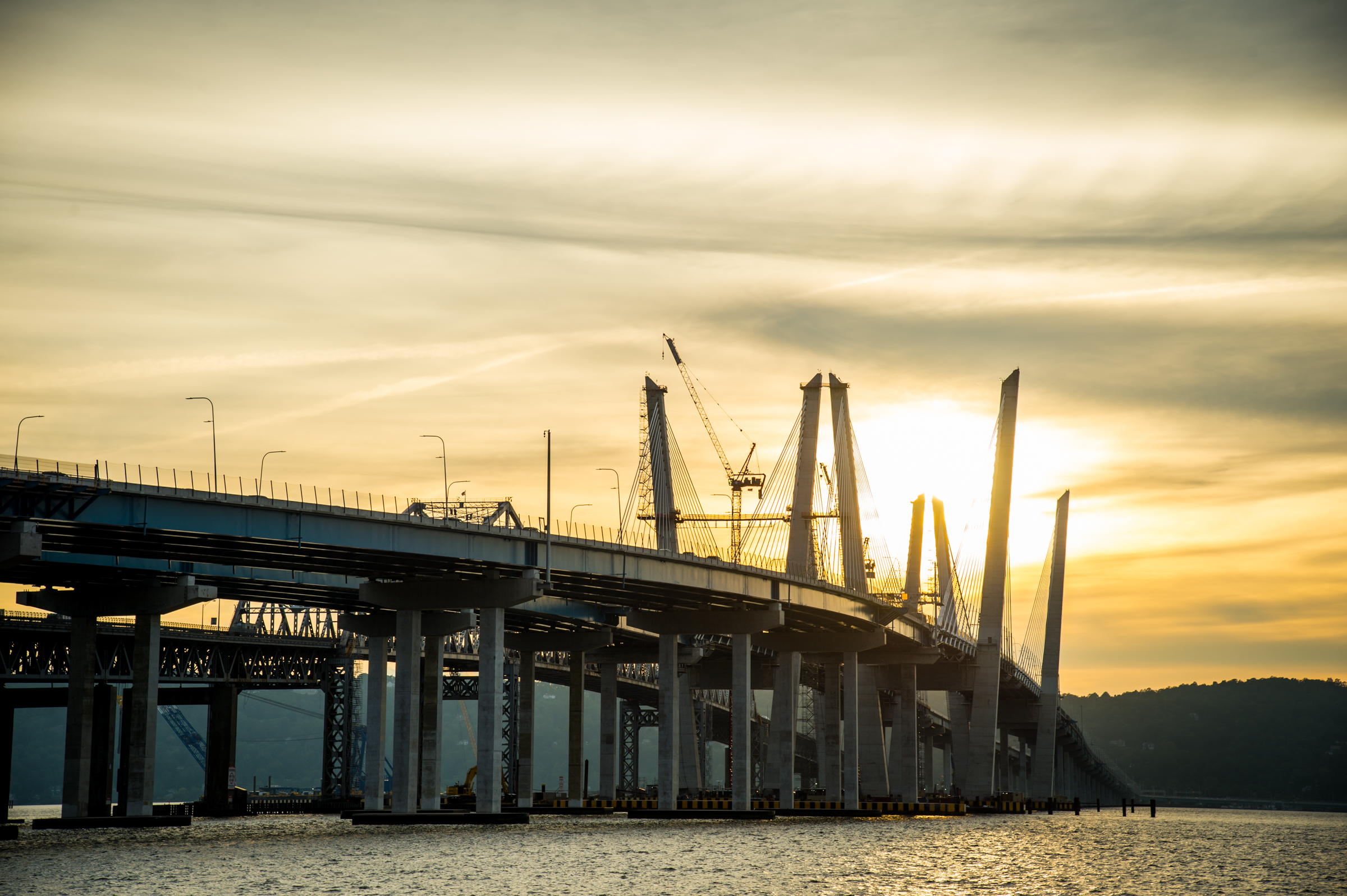
This new bridge, which will fully open to traffic in 2018, replaces the existing Tappan Zee Bridge with a 3.1-mile state-of-the-art, twin-span bridge across the Hudson River between Westchester and Rockland counties.
To say that the project has been newsworthy or highly anticipated for those living in the area, would be an understatement. The $3.98 billion Governor Mario M. Cuomo Bridge is one of the largest single design-build contracts for a transportation project in the United States. Located fewer than 20 miles north of New York City, the cable-stayed span crosses one of the widest parts of the river and will be the largest bridge in New York State history.
While those involved in the bridge were undoubtedly excited to be part of such an impressive project, many will say that working with fellow alumni made it all the more special, and made them prouder to be a Jasper. Here are just a few of their stories.
-
Tom McGuinness ’90
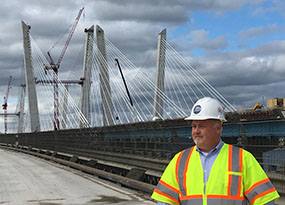
Tom McGuinness ’90 was director of engineering services for the New York State Thruway Authority, the agency overseeing the building of the new Governor Mario M. Cuomo Bridge, when he was asked to join a few different committees that were working on the environmental impact statement for the project. He became increasingly involved in putting together the procurement documents and requests for proposals, and in 2013, when the Authority finalized the selection of the design-build team, he joined the project full time and took on a new role.
As construction compliance engineer for the bridge, it’s his job to manage the construction. McGuinness is responsible for making sure the work is in compliance with the plans, specifications and standards that have been developed and under the provisions of the contract, as well as reviewing schedules to keep work on track.
On any given day, he reviews the daily schedule and coordinates with the design-builder to ensure construction operations will be completed safely and without affecting the New York State Thruway, Metro-North Railroad or the Hudson River shipping channel. He also reviews work plans, proposed design changes and tracks the progress.
“Lately, a lot of our focus has been on the project schedule, with respect to the traffic shift we just completed, ensuring that outstanding items of work were completed in time for that milestone we just passed,” he says, referring to the shift of Rockland-bound traffic to the Governor Mario M. Cuomo Bridge on Aug. 26, after nearly four years of construction.
McGuinness, who began his career with the New York State Department of Transportation, has served as project engineer for a number of major transportation construction projects in the Hudson Valley. Yet, he found that the sheer scope and immense magnitude, not to mention the fast pace, of the new bridge came with some equally big challenges, especially as a number of major components were fabricated and assembled away from the project site.
For example, the concrete components for the bridge’s substructure, large sections for the pile caps and the pier caps were being constructed as far as way far away as Virginia, and structural steel girders were being fabricated in Pennsylvania and North Carolina. There were a lot of moving parts to coordinate once all of these pieces started to arrive on site.
“It was just the pace and how spread out the project was, tracking work from so far away,” McGuinness explains. “The days are fast-paced. There’s a lot of stress, a lot of challenges every day. But I don’t think I’d trade it for anything else.”
Because as grueling as those challenges were, they pale in comparison to the highlights he experienced working on this project.
“Honestly, the big highlight was last weekend (Aug. 26), when we hit a very big milestone in shifting the first traffic onto the new westbound bridge,” he says. “Over the course of the project, there have been many success stories in which we were able to mitigate potential schedule impacts in order to maintain our aggressive schedule.”
-
Tony Canale ’94
Tony Canale ’94, a geotechnical engineer who works for Mueser Rutledge Consulting Engineers, had been consulting for the New York State Department of Transportation on potential alternatives for improvements to the Tappan Zee Bridge Corridor, which included studying rehabilitation alternatives, as well as replacement bridge and tunnel alternatives. Once a bridge was selected as the preferred alternative, Canale became the owner’s engineer for the foundation design oversight.
As part of this work, he and his colleagues reviewed design submissions for conformance with structural requirements in the early stages, and then as construction ramped up, he would go out into the field and provide oversight, for example, of the pile driving, and resolve any comments on the design in time for construction.
For Canale, who is also an adjunct professor in Manhattan’s civil and environmental engineering department, the major challenge on this project was also the biggest highlight: the foundation design.
“During that whole process of reviewing the designs, it was a fairly unique experience — it’s not like we did this before,” he says. “The rock is deep, and one of the areas is more than 700 feet, so the piles needed to be designed as friction piles, while others were designed to bear on rock. The unique foundation conditions were challenging, but it was also the most exciting because you’re working with the best engineers to resolve the foundation design.”
For nearly two decades, Canale has been involved in a wide range of design and construction projects covering transportation, commercial and residential development, and public utility structures. Yet, the scale of the new Governor Mario M. Cuomo Bridge was awe-inspiring.
“I’ve been working for over 20 years, and I’ve never seen things of this size, this magnitude — seeing a whole bridge section of 300-plus feet being lifted at one time,” he says. “The scale of the project is what makes everything.”
There’s still one foundation left in the Rockland abutment to address, but his role has diminished now that the foundations are finished. He’s since started working on other projects in the office but finds it difficult to get back into the normal realm of things, after working on the new bridge, a project that was demanding but exciting, monumental but localized.
“I think if you ask anyone that is here, as hard as this project was in terms of the pressures of schedule, the cost, and this and that, I don’t think anyone would rather be anywhere else, bar none,” Canale says. “It’s an opportunity to do some good for the community in a sense that it’s a tremendous bridge, it’s going to be a tremendous asset for the area.”
-
Robert LaMagna ’84, ’86
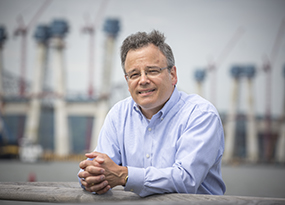
Robert LaMagna ’84, ’86 (M.E.), currently senior project manager at HDR, made a point of reaching out to HDR, where he had previously worked for 12 years, to rejoin the firm and be a part of the new bridge project. A Westchester County native, it was too exciting of a project to pass up.
“The Tappan Zee Bridge is something that I’ve grown up with, frequently driving across it,” he explains. “To see it transformed from the original bridge into the new structure and be part of the design team is something I couldn’t let pass.”
LaMagna has worked for predominantly bridge design firms since he graduated, and with various local clients, including the New York City Department of Transportation, New York State Department of Transportation, New York State Thruway Authority, and Port Authority of New York and New Jersey. In fact, he had been working on the design of another bridge on the Harlem River before he came back to work with HDR.
As the lead designer or discipline lead for the bridge approaches for the Governor Mario M. Cuomo Bridge, LaMagna was responsible for the structural designs of the bridge from abutment to abutment, exclusive of the main span, which includes all the approach spans that lead up to the main span itself on both the Rockland and Westchester sides. He oversaw five or six design teams, and each design team was responsible for a number of approach spans.
During the 14 month-period he spent working on the project, he faced a few difficulties — the fast pace of the schedule, for sure, but also overcoming all of the changes that happen in design.
“Working on an immense project like that with the tight schedule, you have only a certain amount of time to make sure the design is coordinated,” LaMagna says. “There’s a lot of communication involved in making sure that there are no conflicts between certain features of the bridge. “It was almost like an everyday race to just make sure that we’re keeping pace with the design schedule.”
Often working 14-16-hour days, his dedicated design team made the adjustments as needed to maintain the schedule.
By about midway through the project, LaMagna started to see a light at the end of the proverbial tunnel. The teams were completing their sections, and the satisfaction that comes along with finishing the designs was exciting. But working with his team was one of the biggest high points, as well, which LaMagna compares to playing on a competitive athletic team.
“You know, it was like playing in a heated sporting event where you get a lot of team camaraderie — everyone is in the same position, everyone is under the same pressures,” he explains. “Teamwork and communication are a big thing. It’s satisfying at the end of the day knowing that we have our goal in sight, we’re not missing a target, and things are looking good, so that we can deliver on delivery day.”
Eager to drive over the newly opened span, LaMagna felt it all come back to him, as he cruised across the span.
“As engineers, it’s all about design, it’s analysis,” he says. “We see it on paper. But to drive over it and see it in real life, it was just a great reminder of what we had done.”
-
Michael Martello ’08, ’11
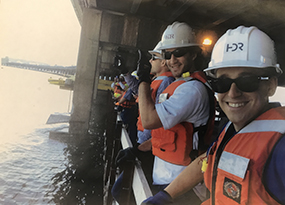
Michael Martello ’08, ’11 (M.S.) became involved with the Governor Mario M. Cuomo Bridge from the beginning, back when his employer, HDR, was pursuing the project and working on its proposal efforts.
He started out as the global analysis task lead, with his primary responsibility being the seismic analysis and design of the approach spans. However, given HDR’s involvement as prime design lead, he played many roles on the project throughout the years. With a project this big, HDR had design teams working across the country, and was pulling resources from multiple offices within the company, in addition to managing a multitude of sub-consultants. One of Martello’s jobs was to make sure that all of those individual design teams were on the same page, meeting the project requirements and following the same technical approach.
Those were his main responsibilities during the design phase. Afterward, Martello became project engineer for the approach spans during construction, and basically was tasked with making sure that the contractor had everything needed during construction, which included answering questions or clarifications on the design, facilitating any necessary design changes, and just ensuring the contractor could build to the requirements, which was a great learning experience for the young engineer.
“Being the project engineer for the approach spans during construction really taught me a lot about how bridges are built, and how certain details during design flush out in construction,” says Martello, who has been with HDR for almost 10 years, starting there as an intern his junior year at Manhattan University.
During his roughly four years on the job, like many of the engineers building the new bridge, the tight timetable was grueling but rewarding in the end.
“The biggest challenge was the schedule — it was a very rigorous schedule,” Martello says, explaining how the contractor was mobilized on site from day one, which essentially means they were designing and building at pretty much the same time. “It takes a certain type of individual to keep up the pace of a design-build project let alone one this big.”
But along with the schedule, the high profile of the project was a bit of a trial.
“This project is the biggest public infrastructure project currently under construction in the United States,” Martello says. “The bridge locally and even nationally is well-known, so there were a lot of eyes on the project. But it was nothing we couldn’t overcome as engineers once we put our mind to it.”
And what began as challenges to overcome also presented themselves as opportunities to assimilate and innovate.
“I think everyone on the project, no matter what they worked on in the past, saw something new on this project,” he says. “Given the size of the project, we were able to innovate so much and use cutting-edge technology and cutting-edge design that we wouldn’t normally get to do on a regular project.”
Although he’s still involved, that’s where Martello left off the project in 2016, when he handed the reins over to a few other Manhattan University engineers, coincidentally, to see the project through to completion.
-
Diana Brown ’15
While Diana Brown ’15 was taking her last course at the University, during the summer of 2015, she took on a part-time role as project controls specialist in the business services department at Tappan Zee Constructors, LLC, which quickly became a full-time job. A year later, she was snatched by the construction division, and started working as a field engineer for the main span superstructure.
While no two days are ever the same, her days consist of preparing for deck pours, setting deck panels, stressing cables in the towers, ordering the correct type of materials — tires, fuses, transformers, plywood, rope, etc. — and making sure there is enough of everything, and that everything is built correctly according to plan and within tolerances. There are also days devoted to CAD (computer-aided design), comprised of calculations, drawings, barge and crane layouts, and meetings — lots of meetings.
Her hours could be allocated to learning about a system as quickly as possible and collecting as much information to then troubleshoot and make repairs, as well as foreseeing safety hazards and not just notating the issue but ensuring that it is corrected. In addition, she devotes a good amount of time to resolving many of the questions that arise each day.
“How many ground heaters should we have and what type to help cure the concrete? How many layers/blankets should we have for a road deck pour in variable 20- to 40-degree ambient temperature? Will we be able to get strength in order to set the next field section?” she asks, just a sample of some of the queries she addresses.
Problem-solving aside, Brown, who spends her days out in the field, found mother nature to be her biggest challenge, and sometimes, her toughest foe. But, as many engineers on the project have said, so was the schedule.
“Working in sideways rain, temperatures in the teens for extended amounts of time,” she says. “Working twice as hard to make up for lost time. Constantly pushing the crews to meet or exceed schedule. The schedule was aggressive. But that is the beauty of such a large complex project, it’s something bigger than yourself. You plant the seed, the tempo, look for opportunities to streamline.”
And working on such a huge and complex project like the Governor Mario M. Cuomo Bridge, where she had the chance to work with various people from so many different fields, also has its benefits.
“Learning from the different trades and people from all around the world. Collaborating between different personalities and work styles. It’s a thrilling sequence — erecting field sections, hauling cable, setting deck panels, installing rebar, pouring concrete. In each sequence, there are different variables, challenges, and then you can drive across the bridge!”
In October, Brown transitioned into another role in the demolition of the existing bridge, as demo lead engineer for area 3 deck.
-
Alessandra Rosso ’14
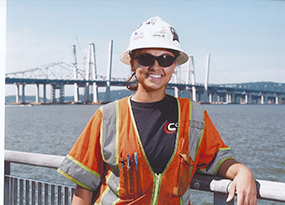
Alessandra Rosso ’14 had been working part time for Granite Construction since her freshman year at Manhattan University. She remembers being in her hydraulic design class when she heard that the joint venture, of which Granite was a part, won the contract for the new NY Bridge. A Bronx native familiar with the former Tappan Zee Bridge, she really wanted to work on the project and participate in such a high-profile job.
“Everyone was interested in it. Not just engineers, everyone. Even now when I tell people where I work, they almost always raise their eyebrows and ask me a question or make a comment,” she notes.
Rosso started working full time on the bridge in May of 2014 (just two days after her Commencement ceremony) as the reinforcing steel or rebar field engineer, which she describes as intense.
“I was the only field engineer assigned to that area and worked more hours than I thought possible,” she says. “I had so much responsibility immediately. I had taken one class at Manhattan University on rebar, and it did not cover most of the real-world problems I had to deal with. Eventually, I learned.”
She was later moved to the stay cables in December of 2015, which was a much different experience given that she worked with a group of engineers.
Her day was evenly split between field work and paperwork. Rosso often starts the day by checking timecards and emails, and then going out into the field to check on the work and talk to the foreman about any concerns or upcoming tasks.
“I’d spend a lot of time inventorying (lots of counting),” she notes. “However, on days when the strand in the stay cables needed to be stressed (it happens about 3 or 4 times a week), I’d spend the day in the towers,” says Rosso, who likens the latter work to being in an igloo during the winter months.
Spending hours up in the air in the cold and wind, where everything surrounding her is frozen, sounds like a major tribulation for anyone, but this recent graduate, who previously worked on the Queens Bored Tunnel at the East Side Access Project and the path station at the World Trade Center, counts the size of the project as her most significant challenge.
“The project is so large, it is very easy to get swallowed by it,” she explains. “There are superintendents, project managers, project engineers, foremen, inspectors, construction managers, and countless others that you interact with almost daily. Things move very quickly, and not listening for a second can make you feel out of the loop.”
Admitting that it’s a kind of boring highlight, staying on budget was something Rosso was especially proud of, considering there was a bit of a learning curve for a team new to keeping a budget.
The Jasper Connection
While some of these alumni started working on the new Governor Mario M. Cuomo Bridge knowing a fellow alumnus or two, most of them didn’t realize the sizable number of Jaspers involved until they got into the field and began meeting the various engineers.
For instance, McGuinness and Canale, who are just a few years apart, met each other while working on this project. They began talking about other alumni whom they had met or heard about, and quickly realized, as they started to count them, that there were quite a few Jaspers involved with the bridge. And, of course, once they started to pay attention, that number just seemed to grow.
“As we worked, and we got in the field, it’s ‘I went to Manhattan College’ or something like that, and that’s when we started adding it up,” Canale says.
Martello remembers that when he joined the project, there were 12 alumni involved, but the more he would talk to people and the more he met people in the field, that list of Manhattan engineers just continued to increase in length.
“You’d see somebody in the field wearing a Manhattan sweatshirt, and you’d say, ‘You went to Manhattan?’ and a conversation would get sparked up,” he says. “I would definitely see Manhattan College engineers when I was out in the field at least once a week. And, of course, a lot of members on the design team that I worked with every day were Manhattan College engineers.”
There are Jaspers spanning from the mid-70s to new graduates and interns, and they are involved in every aspect of the new Governor Mario M. Cuomo Bridge, which Canale attributes to Manhattan’s exceptional education in engineering and its ability to produce great engineers.
“It just speaks to the College that the engineering school, which has been around now for 125 years, has 50 alumni of various ages involved in the planning, design, highway, foundations — cutting through all disciplines — working on the bridge,” Canale notes.
LaMagna had four or five friends also working on the bridge, but he met many of the other alumni engineers for the first time. It didn’t surprise him to learn of all the fellow Jaspers involved.
“It’s a local school, and it’s got a great reputation,” he says. “It gave us all a good education in the engineering basics and in advanced technologies. So, it doesn’t surprise me at all.”
Brown had heard about all of the Jaspers on the job, but it didn’t really become apparent until she started meeting them.
“I initially heard about other alumni, but it didn’t click until I met them,” she says. “It was a series of warm and fuzzies with each Jasper I met. When you get to the real world and see other competent people that graduated from the same institution, you realize that the engineering departments have done something right.”
There aren’t any other schools that could compare to Manhattan College in terms of graduates associated with the project. While the Thruway Authority is based upstate, and tends to have a lot of University at Buffalo (UB) alumni among its ranks, even UB, with its eight or nine alumni, couldn’t compete with the large number of Manhattan representatives.
It did lead to a little bit of competition, however, and there was a mention of UB wanting to challenge Manhattan College to a softball game. But as McGuinness jokingly points out, they couldn’t field a team.
In all seriousness, McGuinness notes that this Manhattan connection has existed throughout his years in the industry.
“As soon as I graduated, I realized every project that I’ve been involved with, it seemed like every office I walked into, there was somebody that identified as an alumnus, so I had that link to somebody in every project,” he says. “As diverse as this project is, Manhattan College seems to have involvement in every corner.”
Canale adds that if someone had told him, when he was a senior in college, that one day he’d be working on a project like this, he would have laughed it off as being crazy — he couldn’t even process how to get to that point. Looking back now, he credits the College for helping him get to that point — to be a part of such an exciting and historic project. And that association isn’t lost on him.
“I was sitting here at the opening ceremony, and I texted Dr. Moujalli Hourani [associate professor of civil and environmental engineering],” he recalls. “I just said, ‘I want to thank you for everything you’ve done for me.’ These professors care so much about us, and really helped us along. I think if you talk to any one of these alumni, they would say that, too. You just don’t ever feel too far from Manhattan College.”